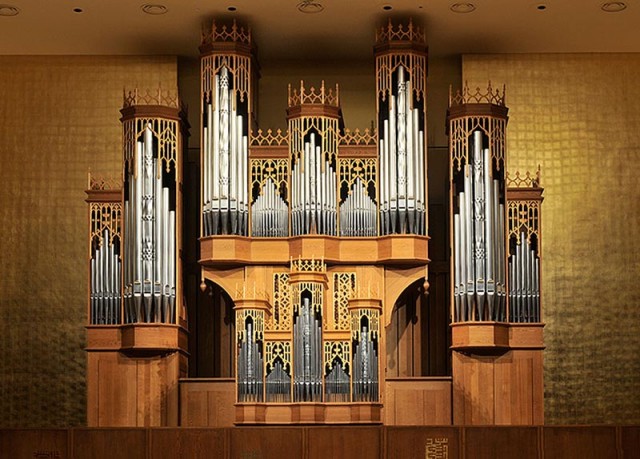
UC Berkeley's Hertz Hall Debuts a New Old-School Organ
Davit Moroney sits in the organ loft at UC Berkeley's Hertz Hall. Above him soar the silver pipes of the hall's new Noack organ, peeking out from behind some ornately carved wooden screens. The instrument looks a bit like one Johann Sebastian Bach might have played in the early 18th century.
Moroney, a music professor at Berkeley and organist and harpsichordist, says that as much as he cares about the the way the new organ sounds, he also cares deeply that’s it’s a handsome object. "I’m a strong believer in the fact that if people are looking at something beautiful, they think it sounds even more beautiful," he says.
The organ is new to Hertz Hall, but not brand new. It came from a church in Wilmington, Del., that didn’t need the massive instrument anymore.
It was built by the Noack Organ Co. of Georgetown, Mass., in 1982. The company brought the organ back to its shops in Massachusetts to refurbish it and installed it at Hertz over the summer.
The Noack replaces an electronic organ first installed in Hertz Hall in 1958. The old organ was fine, Moroney says, but its electronic action made it better suited to 20th century music and ill-fitted for the core of the classical organ repertory, written by composers like J.S. Bach and his mentor, Dietrich Buxtehude, in the 17th and 18th centuries.
The new organ’s mechanical action allows for great range of dynamics.
“If I play slowly, it’s almost like it’s breathing,” Moroney says as he taps out a soft, then a louder note. “All musical instruments are really a kind of speech, just not using words, but using notes.”
Moroney says by the difference in touch allows the musician to add clarity to the sound. It’s the equivalent of consonants in language.
“It gives a variety to the rhetoric of what we’re playing, by the variety of touch that you can get,” he says.
Moroney will play some very loud rhetoric this Friday, Saturday and Sunday, when he performs, with the UC Berkeley Symphony Orchestra, Saint-Saens' 3rd Symphony. It’s popularly known as "The Organ Symphony" and features what Moroney calls “the loudest chords in the world.”

